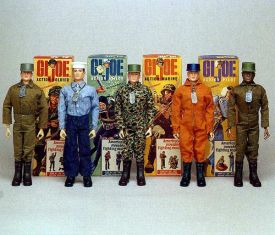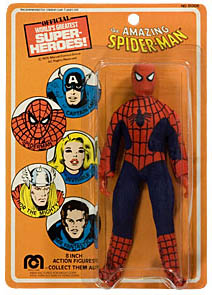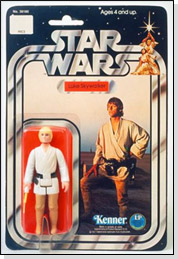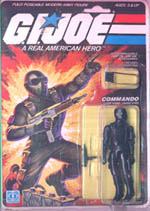- Comics
- Comics Reviews
- Manga
- Comics Reviews
- European Comics
- News
- Comics News
- Press Releases
- Columns
- Spotlight
- Digital Comics
- Webcomics
- Cult Favorite
- Back Issues
- Webcomics
- Movies
- Toys
- Store
- More
- About
By Christopher Moshier
June 26, 2008 - 18:25
 |
The toy was conceived as a military man with different names for each branch of the armed services; Skip for navy, Rocky for the Army and Marines, and Ace the air force pilot. Fred Bruns, who headed Hassenfeld’s ad agency, advised Don Levine to find one solid name to attach to the product. You can actually thank Robert Mitchum and Burgess Meredith for the help in naming the first action figure. Late one night, Levine was watching an old movie about war correspondent Ernie Pyle starring Mitchum and Meredith. The title of the film was "The Story of G.I. JOE."
TRIVIA: Burgess Meredith had a starring role in the 1987 animated G. I. Joe: The Movie.
 |
TRIVIA: In 1968, the Hassenfeld Brothers Co. changed its name to Hasbro.
The Mego Corporation was founded in the early 1950s by David Abrams and was mostly known prior to 1971 as a producer of dime store toys. It was the founder’s son, Martin, who changed the focus of the company. After a failed attempt to copy the G.I. Joe trend with their Action Jackson figure Mego began purchasing license rights to a variety of successful franchises. Star Trek, Planet of the Apes, DC, and Marvel Superheroes were just a few of those famous properties. As G.I. Joe sales were slacking in the 1970s Mego ruled the action figure market.
 |
In 1976, it was the beginning of the end for Mego when they rejected to license a deal for a science fiction movie being released called Star Wars. Star Wars became a merchandising juggernaut. Seeing the error of their ways Mego started buying up manufacturing rights to any and all potentially successful motion picture and television licenses that were available. Nothing ever caught on and with the competition introducing the next generation of action figures Mego closed their doors in 1983.
By 1978, the oil crisis led to a jump in the price of plastic, and G. I. Joe was among the toy lines discontinued in that year. To cut manufacturing costs a Japanese toy producer (Takara Co.) introduced a new standard with their 3 3/4 inch figures. In the same year Kenner Products began releasing a toy line based on the popular movie Star Wars. The line introduced figures standing (on average) only 3 3/4 inches tall. While detailing was crude, the toys were more affordable both to produce and to buy, and vehicles and other accessories were easier to design for the smaller figures.
TRIVIA: Kenner Products was bought out by Hasbro in 1991.
 |
In 1983, federal regulations prohibiting the creation of children's programming based on toys were lifted. This opened a new era in action figures. He-Man, Thundercats, Teenage Mutant Ninja Turtle, Silverhawks, Transformers, Mask – the list is quit substantial. You may not recognize all the action figure lines listed, but they all had one thing is common – they were all based on a cartoon series. This practice of basing a cartoon on an action figure line became one of the largest marketing tools for toy companies being equally as true even today.
TRIVIA: In 1969, the FCC (Federal Communication Commission) prohibited television shows based on toy products.
 |
Today, there is not one property or concept that an action figure producer would shy away from. In this age of merchandising and royalties anything and everything is fair game from comics to animation, from the adult industry to sports figures, from television to movies. There is such a wide range of licenses that people who wouldn’t normally collect would pick up an Elvis Presley figure for their mother for her birthday or John Wayne for dad at Christmas. With such a broad audience smaller toy companies have sprung up over the past decade putting even the larger companies to task in quality and presentation. The action figure market is peaking. It will be interesting to see how it evolves from here.